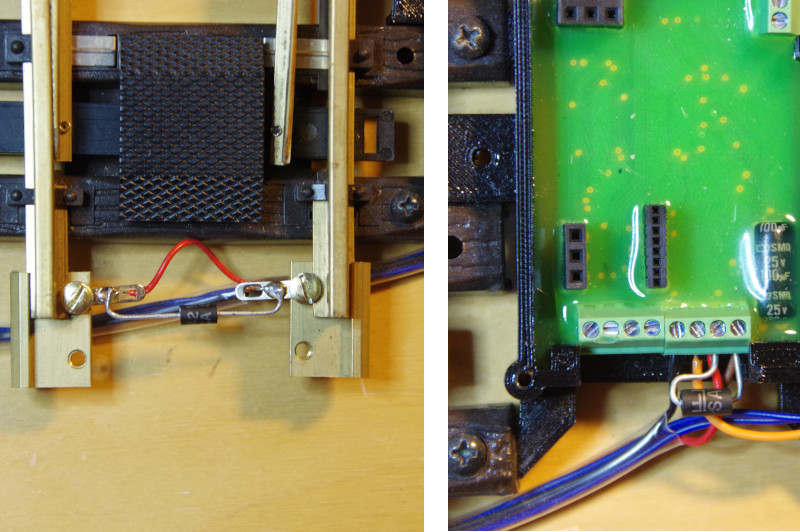This document is dedicated to the infrastructure that you only have to build once for a model railway layout. In CTC, these are the power supply and the Wi-Fi router.
Power Supply
Attention, an unsuitable power supply can irreparably destroy the CTC modules!
For a model railway that operates exclusively with CTC modules, we recommend the purchase of a short-circuit proof switching power supply for direct current. At Reichelt, for instance, you can acquire the following recommendable desktop power supplies:
Those who prefer flexibility can opt for a laboratory power supply, such as PeakTech 6226. The advantage of these is that they include a display for voltage and current, but they also have the following disadvantages:
- You can accidentally adjust the voltage, and then destroy all CTC modules at the next switch-on.
- A lab power supply does not usually switch off in the event of a short circuit but only restricts the current to an adjustable value.
If you are considering mixed operation with analog or older digital technology, you should consider the following:
- The CTC modules are not suitable for alternating current (AC) or unsmoothed direct current (DC) in their default state. Especially, old model railway transformers often supply unsmoothed direct current.
- So-called digital power (alternating current with approx. 10 kHz) can be used without worry for CTC modules.
- If you use a separate power supply for your CTC modules, you must ensure that there are really no cross connections between CTC module and rail power. A classic example is the old Märklin turnout, in which a cross connection between rail and turnout drive exists via the turnout lantern. If alternating current is on the track, without a protective diode over this bulb, the CTC module will be destroyed.
#
Power Requirements
When choosing a new power supply, the question naturally arises, how much power must it provide? Here are a few reference points:
- You can find the power requirement of each CTC module in its respective data sheets.
- Add to that the power demand of the simultaneously running locomotives.
- With the lighting switched on, the good old light bulbs play an important role.
- While turnouts require a lot of power, they only do so when they switch. The inrush current is most relevant here, as the CTC modules usually set the turnouts to their default position at the start.
The simplest way to reach a reasonable value here is to measure, especially the inrush current, and round up generously from the measured value.
To reduce the inrush current, you have the following options:
- You define a default value in the config for your turnouts which does not exist. In this case, however, the turnout is in an undefined state from the point of view of the CTC app.
- In addition to the previous point, you can sequentially initialize the turnouts either by using triggers or at the push of a button. We will no doubt dedicate an article to this topic at some point. Until then, feel free to contact us if needed.
#
Alternating Current and Unsmoothed Direct Current
In principle, the use of CTC modules is possible, even with alternating current and unsmoothed direct current. However, measures to protect the CTC modules must be taken before they are put into operation:
- For all CTC modules, a suitable supporting capacitor is needed to smooth the input voltage. Current turnout modules and IO-boards are already equipped with such a supporting capacitor.
- There must be no unprotected cross connections between CTC module and track current (see below)
- Old transformers tend to react to short circuits with severe voltage surges.
See the section “Overvoltage Protection” below for this.
Protecting Cross Connections
Here are some examples of cross connections and how they can be protected:
- Old Märklin turnout (M-track): Install a protective diode between the bulb of the turnout lantern and the turnout drive.
- Old Märklin locomotives, where one pole of the light is permanently connected to the case: Install a protective diode between the bulbs of the front/rear lighting and the connection to the CTC-locomotive module-H0a.
Overvoltage Protection
All power outputs (motor, switching outputs, half-bridges) of the CTC modules are protected against short-circuit and overload, but the maximum voltage of 24 volts must not be exceeded at the input. For transformers without electronic regulation, it can happen that in case of a short circuit, a short-term high induction voltage at the track input of the CTC modules is created, damaging or destroying them. This risk is especially high when using old transformers.
But also a switching power supply tries to compensate for a current increase as caused by a short circuit. While overshoots of the regulation cannot be prevented, they should actually be so brief that the electronics attached to it do not suffer any damage. However, there will be hardly any power supplies that were specifically designed for the use case of garden railways, and certainly not for CTC. So it may well be that even when using a modern switching power supply, deadly overvoltages occur for CTC modules.
Also, the interplay of the remaining electrics/electronics installed in the model railway can amplify overvoltages or outsmart the regulation of a switching power supply. Thus, many unfavorable factors in sum could just be the tick too much for CTC modules or other electronics.
Since this knowledge is based on specific customer experiences, we have looked for a protection option. TVS diodes are the electronic components for this purpose, e.g. the SA24CA from Littlefuse. Starting in February 2025, we include such a TVS diode with all CTC switching modules and CTC locomotive modules for G-gauge. For the small gauges, it should be enough if TVS diodes are installed on the track. For already delivered CTC modules, we include the TVS diodes with the next order.
The dimensioning of the diodes is a compromise between size and protection. Whether they can withstand the voltage jump of a transformer has to be shown in practice - we can’t provide any guarantee for that. In this respect, we can only recommend replacing the old transformer with a modern electronically regulated power supply, so that no overvoltage occurs in case of short circuits.
The TVS diode is simply placed between the two track connections (Track A and Track B). Since it is polarity-proof, nothing can go wrong. Installation in the power supply to the track or just at any point on the track is also conceivable. If TVS diodes are installed in several places in the setup, they protect the CTC modules in case of a short-circuit. Also, electrostatic charges (ESD) are avoided by the TVS diodes.
Here are two examples for the installation of a TVS diode, on the left on the track and on the right at the track input of the CTC turnout module G2:

Wi-Fi Router
In principle, everything that supports 2.4 GHz and WPA2 encryption should work. The CTC modules and the CTC app must be able to communicate with each other unhindered via UDP and HTTP. If the router also supports 5 GHz, this frequency can be used for the tablet, smartphone, and PC, which can further increase reliability, as all data packets must then take the path via the router. Due to good experiences and widespread use, we have chosen the FRITZ!Box 4040 as our CTC router.
If you order a CTC router, regardless of if it’s part of the starter set or separately, you will receive it fully configured. Since we are then aware of the network name (SSID) and the network identification (password), you will always receive your CTC modules from us, already checked into your model railway Wi-Fi. This service is the reason for the price increase of the CTC router compared to a standard FRITZ!Box.
Principally, there’s nothing to stop you from configuring your model railway Wi-Fi yourself. Checking the CTC modules is remarkably simple, as you can read in Chapter 3 - Check modules into Wi-Fi. But configuring the Wi-Fi can indeed present a challenge. If you’re not confident doing this, we recommend the CTC router or the starter set.
Please understand that we may not be able to provide much assistance in installing routers that we are not familiar with.
#
Wi-Fi Router in the Garden
Of course, when operating in the garden, outdoor suitability must be considered.
For our garden railway, we use a CTC router (FRITZ!Box) in the house (e.g. in the locomotive garage) and extend the Wi-Fi with an outdoor access point (TP-Link AC1200).



